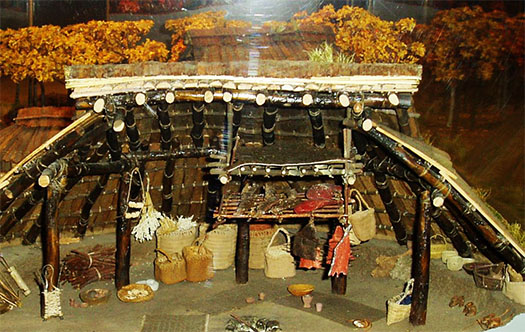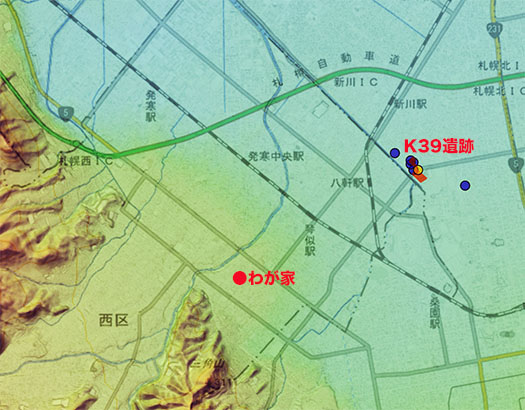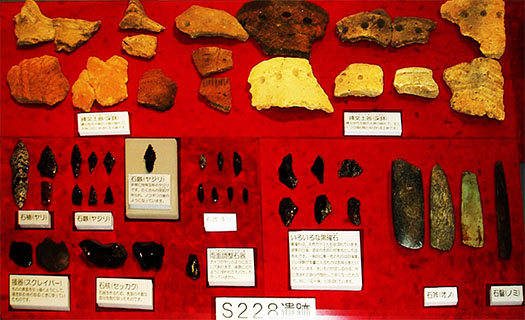

自分自身の情報メディア人としての「終活」を兼ねて、撮影してきた大量の写真類を整理整頓作業。まぁ基本的には自分の興味のおもむくままに撮りためてきた写真データなのですが、着手してみるとその大量さに驚かされる。これを基礎に別途まとめ作業していくのは、多大な労力だとほとほと実感(泣)。
しかしまぁ、自分自身での整理整頓であり、過去に自分がたどってきたことの追体験なので、興味のありかはしっかり浮かび上がらせることはできる。時間と労力はかかるけれど、あらたな気付きもあって有意義であります。
そんななかに札幌市埋蔵文化財センターの取材写真が発見された。
文字記録のない時代の人間記録からその時代相を掘り起こしていく、それも住まいと暮らしという側面から照射して事実把握を行っていくという作業は自分自身でもかなり刺激的です。で、確認作業を進めていったら不覚にも、この埋蔵文化財の発見場所はわが家から2-3kmほどの北大構内だと知れた。K39遺跡と名付けられて位置は札幌市北区北23条西14で、わたしがよく散歩する宮の森地区から北大方向に流れていく「琴似川」の流域地域だというのですね。俄然、整理整頓作業に加速スイッチが入ってしまった。
展示ではジオラマに発掘成果が落とし込んであって、暮らしぶり・住まい方などの情報がクリアに明示されている。
この段階、西暦で600年代後半から1100年代にわたる時期の北海道は「擦文時代」という、続縄文から少し発展した時代相。基本的には狩猟採集社会が継続している時代。最終的には鎌倉幕府の成立によって、あまり実質はないけれど、直轄地域として認識されていった。アイヌ文化期へと引き続いていく時代。それまでは「竪穴住居」だったものが、アイヌ期には「平地型」住居に変容していく。この住居形式の変化は非常に興味深く、アイヌ民族という存在のナゾにも繋がっていくと思っています。

遺跡の説明としては以下。「K39遺跡は旧琴似川沿いに北海道大学構内とその周辺に広がる遺跡。1996年から1999年に市内の「環状通」の改築にともない調査を実施。調査の結果、擦文時代の竪穴住居跡、焚き火跡、土器・鉄製小刀・斧・琥珀製の玉などとともに、アワ・キビ・ヒエ、サケ・エゾシカ・カワシンジュガイなどの食料の一部も発見。また、古い川跡からは川を横切るように打ち込まれた杭列(漁撈用の杭?)や舟・矢・杵・容器・箸・櫛・杭・編み具・おもり・カンジキ、縄・ヒモ・わらじなどの繊維製品が大量に出土。木製品などの腐りやすい生活具がまとまってみつかることは珍しく、当時の生活の様子が顕在化している」。<要旨>
いちばん上のジオラマは当時の竪穴住居の様子。結構大型で繊維製品の「袋」に多量の植物性保存食が確保されている様子がわかる。
ということで、ジオラマや発掘品などを素材にして1000年以上前の先人と対話を試みたい。
English version⬇
Exploring the “Abrasive Culture” Site in Sapporo, Hokkaido, over 1,000 years ago.
The history and life of people are visualized in a realistic way right under our noses! It is a pleasure to be able to compare and contrast with the ancient times in the Honshu area. The “Rubbun” site is located right next to our house.
I have been organizing the large number of photos I have taken as part of my “life after death” as an information media person. Basically, it is the photo data that I have been taking as my interests dictate, but when I started, I was surprised at the sheer volume. I realized how much effort it would take to organize this data into a separate set of basic data (I cried).
However, since this is my own reorganization, and since I am reliving what I have done in the past, I am able to clearly see where my interests lie. It takes time and effort, but it is also meaningful because it brings new insights.
In the midst of all this, I discovered a photograph taken by the Sapporo City Archaeological Center.
It is quite stimulating for me to dig up human records from a time when there were no written records, and to grasp the facts from the aspect of housing and daily life. As I proceeded with the confirmation work, I was surprised to learn that this buried cultural property was discovered on the campus of Hokkaido University, about 2-3 km from my house, in the area of the “Kotoni River” flowing from the Miyanomori area where I often take a walk to the direction of Hokkaido University, in Kita 23-jo Nishi 14, Kita-ku, Sapporo City. I was suddenly turned on to organizing the exhibition.
In the exhibition, the results of the excavation were incorporated into a diorama, clearly indicating the lifestyle and way of living.
Hokkaido at this stage, from the late 600s to the 1100s A.D., is in the “Scrubun period,” a slightly developed phase from the post-Jomon period. Basically, it was a period when hunter-gatherer society continued. Eventually, with the establishment of the Kamakura shogunate, Hokkaido was recognized as a region under its direct control, although it did not have much substance. A period that continued into the Ainu cultural period. What had previously been “pit dwellings” were transformed into “flatland” dwellings during the Ainu period. This change in housing form is very interesting, and I believe it is connected to the riddle of the existence of the Ainu people.
The following is a description of the site. The K39 site is located in and around the Hokkaido University campus along the old Kotoni River, and was surveyed from 1996 to 1999 in conjunction with the reconstruction of the “Ring Road” in the city. As a result of the survey, we found the remains of a pit dwelling from the Aburumon period, the remains of a fire, earthenware, iron swords, axes, and amber beads, as well as some foodstuffs such as millet, millet, Japanese millet, salmon, Ezo sika deer, and Japanese mussels. In addition, a row of piles (fishing piles?) driven across the river were found at the site of an old river. A large amount of textile products such as boats, arrows, pestles, containers, chopsticks, combs, stakes, weaving tools, weights, candlesticks, ropes, twine, and straw sandals were also excavated from the old river site. It is rare to find wooden products and other perishable household utensils in such large quantities, and this is a clear indication of the way of life at that time. <Summary
The diorama at the top shows a pit dwelling of the period. It is quite large, and you can see that a large amount of plant food was stored in textile “bags.
Therefore, we would like to try to have a dialogue with our ancestors more than 1,000 years ago using the diorama and excavated items as materials.
Posted on 12月 6th, 2023 by 三木 奎吾
Filed under: 住宅マーケティング, 日本社会・文化研究







コメントを投稿
「※誹謗中傷や、悪意のある書き込み、営利目的などのコメントを防ぐために、投稿された全てのコメントは一時的に保留されますのでご了承ください。」
You must be logged in to post a comment.